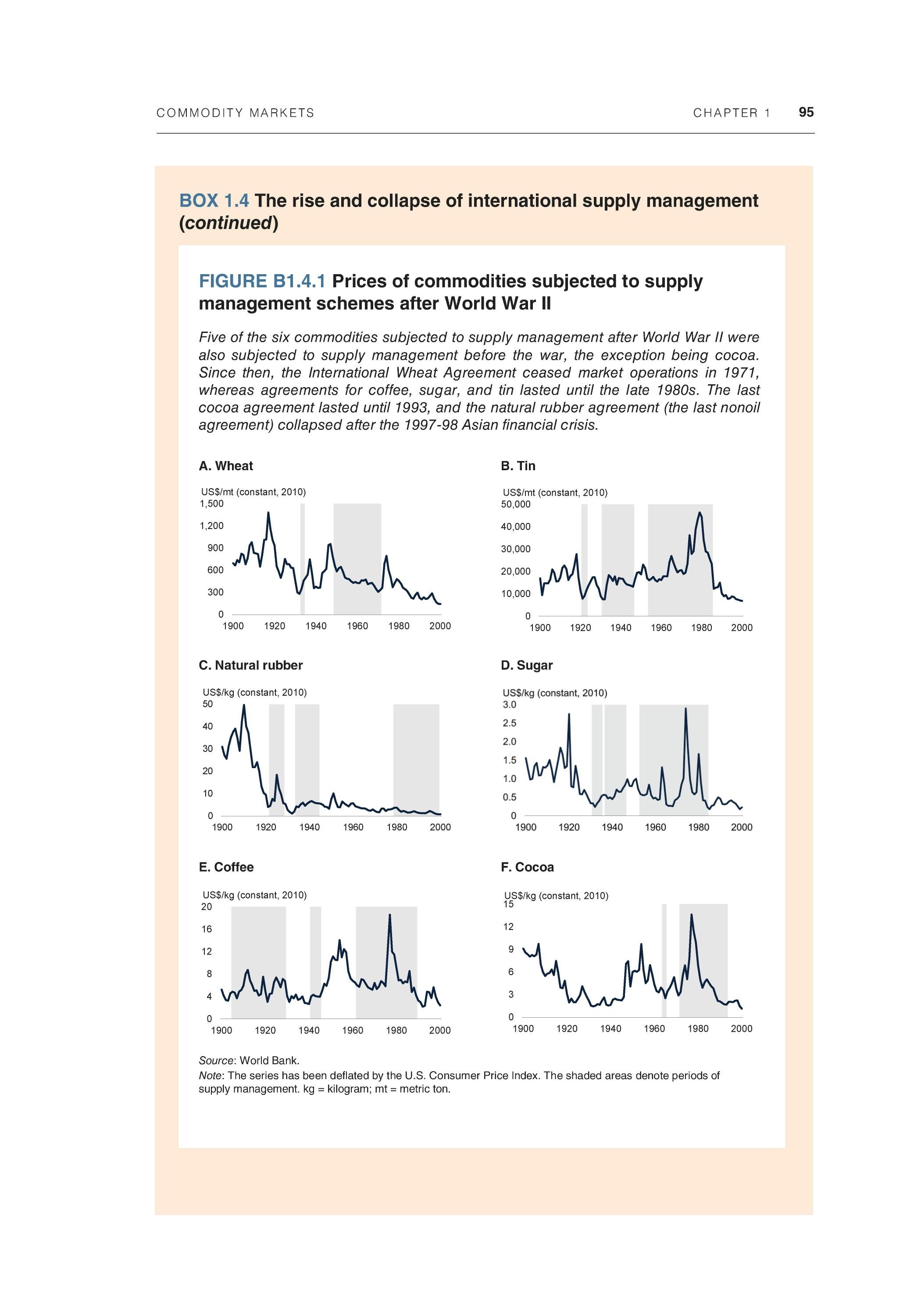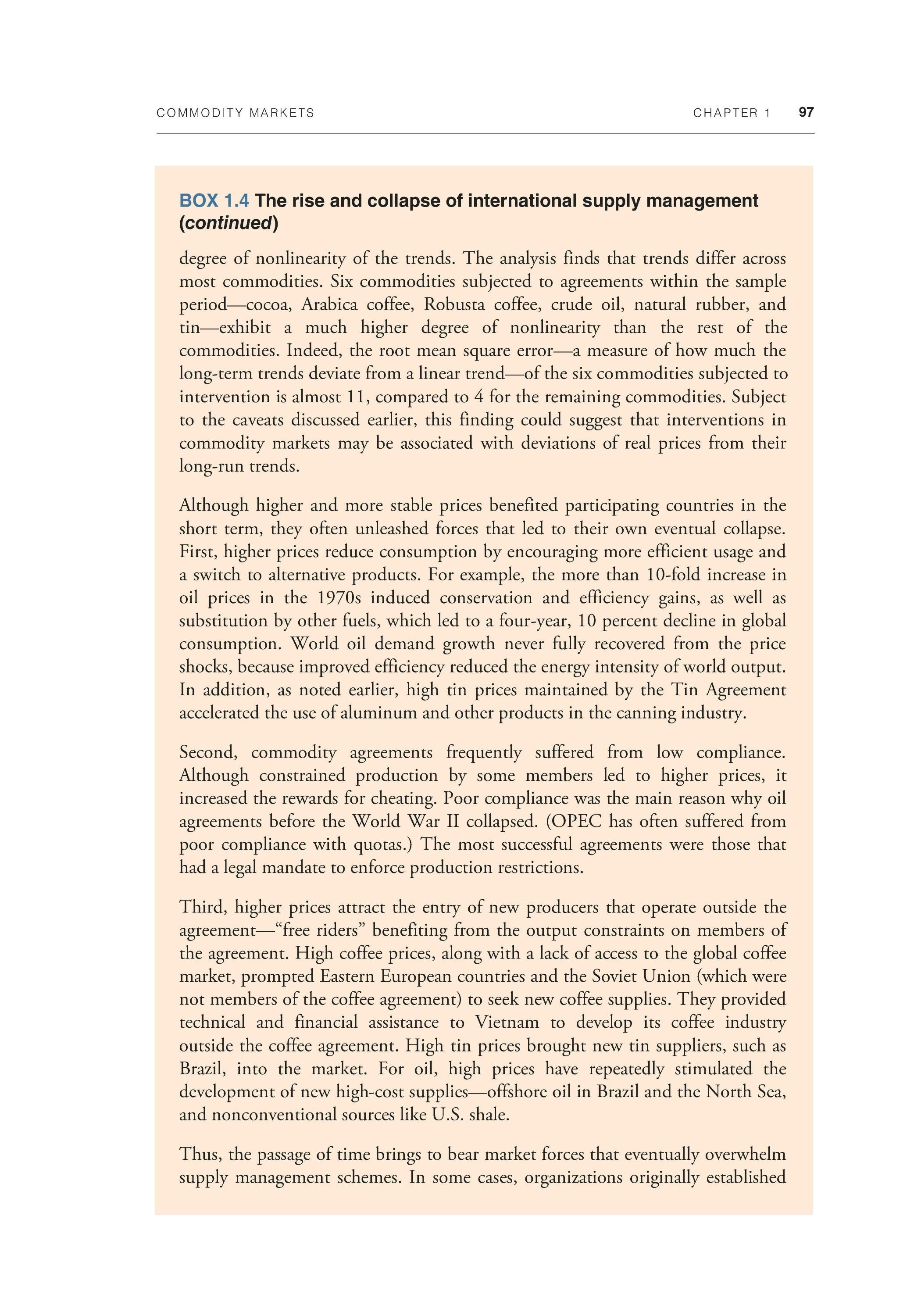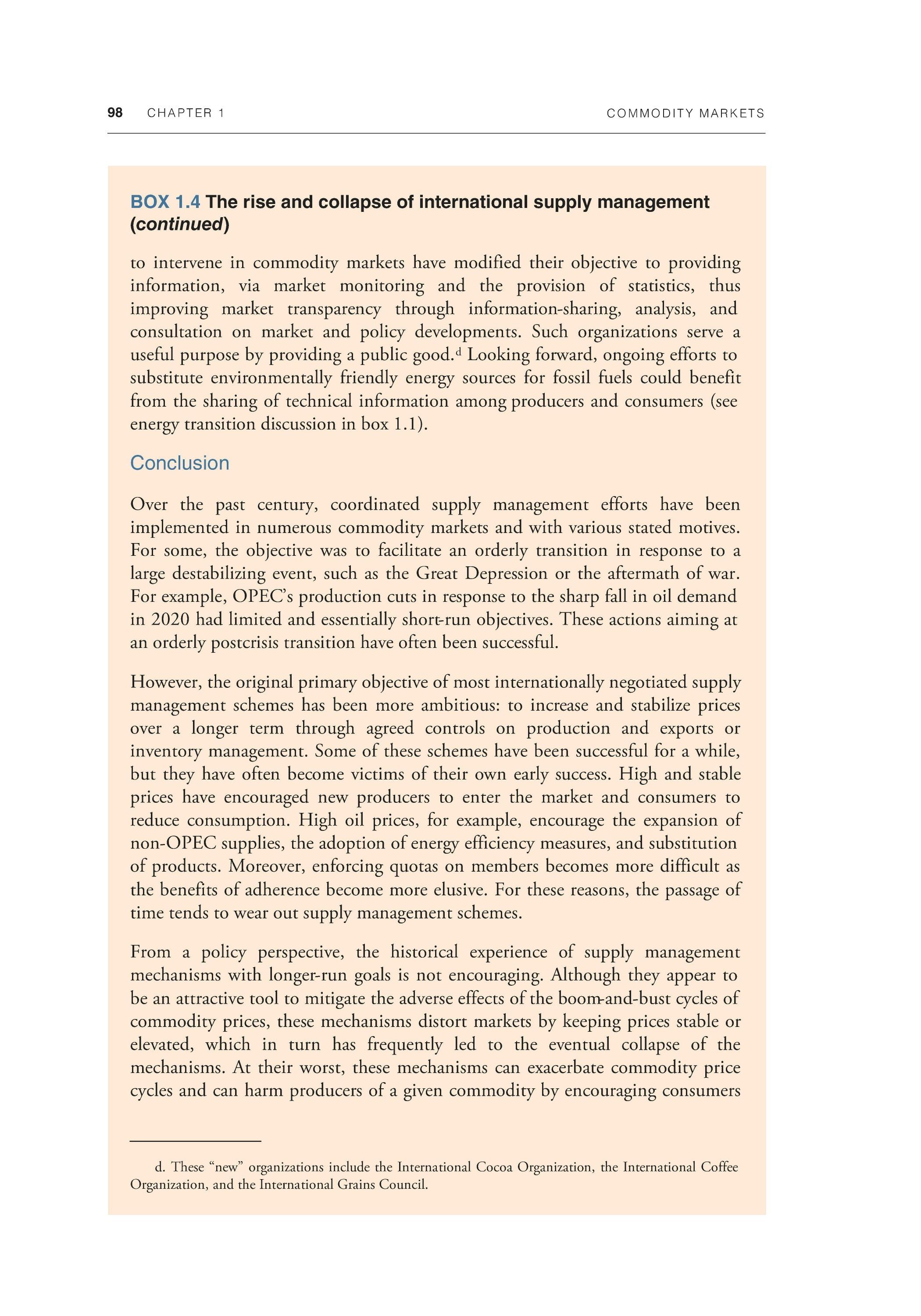
7 minute read
World War II
COMMODITY MARKETS CHAPTER 1 95
FIGURE B1.4.1 Prices of commodities subjected to supply management schemes after World War II
Five of the six commodities subjected to supply management after World War II were also subjected to supply management before the war, the exception being cocoa. Since then, the International Wheat Agreement ceased market operations in 1971, whereas agreements for coffee, sugar, and tin lasted until the late 1980s. The last cocoa agreement lasted until 1993, and the natural rubber agreement (the last nonoil agreement) collapsed after the 1997-98 Asian financial crisis.
A. Wheat B.Tin
C. Natural rubber D. Sugar
E. Coffee F. Cocoa
Source: World Bank. Note: The series has been deflated by the U.S. Consumer Price Index. The shaded areas denote periods of supply management, kg = kilogram; mt = metric ton.
96 CHAPTER 1 COMMODITY MARKETS
The most durable international arrangement for supply management has been OPEC. It has attempted to set production quotas for its members and thereby stabilize the price of oil at a high level. Adherence to the quotas by members has, however, been mixed. And the periods of high prices that OPEC has achieved have encouraged new sources of supply—such as North Sea oil and shale oil. Moreover, changes in strategy by leading members have caused occasional extreme volatility in oil prices.
Impact of supply management schemes
There is strong empirical evidence that international agreements have had an impact on commodity prices. However, measuring their exact impact is challenging because other things are continually shifting. For example, although the Tin Agreement in itself may have put upward pressure on tin prices, concurrent technological advances were making aluminum a superior substitute. The rest of this section summarizes the literature on the subject, discusses some summary statistics, and gives some model-based results looking at all commodities.
Brazil's first coffee supply restriction in 1905 successfully raised and stabilized prices, and was renewed twice (Krasner 1973). Similarly, the 1921 agreement to limit the sale of tin inventories accumulated during World War I succeeded in stabilizing prices (Baldwin 1983). Numerous studies have concluded that most post-Wo rid War II agreements had a substantial impact on prices. See, for example, Akiyama and Varangis (1990) for coffee, Chandrasekhar (1989) for tin, and Verico (2013) for natural rubber.

Figure Bl.4.2 reports price changes after the collapse of an agreement for six nonoil commodities. The change is gauged by the three-year average of the inflation-adjusted price after the collapse minus the three-year average before it. In four cases (sugar, Arabica coffee, Robusta coffee, and tin), prices dropped by about 50 percent after the collapse of the agreement. However, prices increased substantially after the cocoa and wheat agreements expired, but did not change for natural rubber. These declines in prices suggest that the agreements, as long as they were in effect, helped lift prices. It is also important to note that the increase in the price of wheat coincided with the 1970s commodities price boom.
To further examine the relationship between commodity agreements and prices, we present summary results adopted from the price decomposition model reported in chapter 3. The model, which looks at the behavior of 27 inflationadjusted commodity prices from January 1970 to December 2019, decomposes real prices into cycles (up to 20 years) and trends. One can then examine the
COMMODITY MARKETS CHAPTER 1 97
degree of nonlinearity of the trends. The analysis finds that trends differ across most commodities. Six commodities subjected to agreements within the sample period—cocoa, Arabica coffee, Robusta coffee, crude oil, natural rubber, and tin—exhibit a much higher degree of nonlinearity than the rest of the commodities. Indeed, the root mean square error—a measure of how much the long-term trends deviate from a linear trend—of the six commodities subjected to intervention is almost 11, compared to 4 for the remaining commodities. Subject to the caveats discussed earlier, this finding could suggest that interventions in commodity markets may be associated with deviations of real prices from their long-run trends.
Although higher and more stable prices benefited participating countries in the short term, they often unleashed forces that led to their own eventual collapse. First, higher prices reduce consumption by encouraging more efficient usage and a switch to alternative products. For example, the more than 10-fold increase in oil prices in the 1970s induced conservation and efficiency gains, as well as substitution by other fuels, which led to a four-year, 10 percent decline in global consumption. World oil demand growth never fully recovered from the price shocks, because improved efficiency reduced the energy intensity of world output. In addition, as noted earlier, high tin prices maintained by the Tin Agreement accelerated the use of aluminum and other products in the canning industry.

Second, commodity agreements frequently suffered from low compliance. Although constrained production by some members led to higher prices, it increased the rewards for cheating. Poor compliance was the main reason why oil agreements before the World War II collapsed. (OPEC has often suffered from poor compliance with quotas.) The most successful agreements were those that had a legal mandate to enforce production restrictions.
Third, higher prices attract the entry of new producers that operate outside the agreement—"free riders" benefiting from the output constraints on members of the agreement. High coffee prices, along with a lack of access to the global coffee market, prompted Eastern European countries and the Soviet Union (which were not members of the coffee agreement) to seek new coffee supplies. They provided technical and financial assistance to Vietnam to develop its coffee industry outside the coffee agreement. High tin prices brought new tin suppliers, such as Brazil, into the market. For oil, high prices have repeatedly stimulated the development of new high-cost supplies—offshore oil in Brazil and the North Sea, and nonconventional sources like U.S. shale.
Thus, the passage of time brings to bear market forces that eventually overwhelm supply management schemes. In some cases, organizations originally established
98 CHAPTER 1 COMMODITY MARKETS
to intervene in commodity markets have modified their objective to providing information, via market monitoring and the provision of statistics, thus improving market transparency through information-sharing, analysis, and consultation on market and policy developments. Such organizations serve a useful purpose by providing a public good.d Looking forward, ongoing efforts to substitute environmentally friendly energy sources for fossil fuels could benefit from the sharing of technical information among producers and consumers (see energy transition discussion in box 1.1).
Conclusion
Over the past century, coordinated supply management efforts have been implemented in numerous commodity markets and with various stated motives. For some, the objective was to facilitate an orderly transition in response to a large destabilizing event, such as the Great Depression or the aftermath of war. For example, OPEC's production cuts in response to the sharp fall in oil demand in 2020 had limited and essentially short-run objectives. These actions aiming at an orderly postcrisis transition have often been successful.
However, the original primary objective of most internationally negotiated supply management schemes has been more ambitious: to increase and stabilize prices over a longer term through agreed controls on production and exports or inventory management. Some of these schemes have been successful for a while, but they have often become victims of their own early success. High and stable prices have encouraged new producers to enter the market and consumers to reduce consumption. High oil prices, for example, encourage the expansion of non-OPEC supplies, the adoption of energy efficiency measures, and substitution of products. Moreover, enforcing quotas on members becomes more difficult as the benefits of adherence become more elusive. For these reasons, the passage of time tends to wear out supply management schemes.

From a policy perspective, the historical experience of supply management mechanisms with longer-run goals is not encouraging. Although they appear to be an attractive tool to mitigate the adverse effects of the boom-and-bust cycles of commodity prices, these mechanisms distort markets by keeping prices stable or elevated, which in turn has frequently led to the eventual collapse of the mechanisms. At their worst, these mechanisms can exacerbate commodity price cycles and can harm producers of a given commodity by encouraging consumers
d. These "new" organizations include the International Cocoa Organization, the International Coffee Organization, and the International Grains Council.










